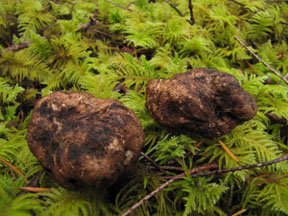
Post-Doctoral Research Associate
Department of Plant Pathology
University of Florida, Gainesville
2004 B.S., Computer Science, University of California, Santa Cruz.
2004 B.A. with Honors, Environmental Studies (Agroecology), University of California, Santa Cruz.
Research Interests and Background
I am broadly interested in the systematics, evolutionary biology and ecology of fungi as well as mutualistic relationships between fungi and plants. Specifically, I am fascinated by ectomycorrhizal (EM) symbioses and their influence upon plant establishment, forest community structure and ecosystem stability. My training in computer science expands the breadth of my research by enabling me to incorporate computational methods of data analysis. Prior to graduate study, I pursued a career as a restoration ecologist in the employ of Central Coast Wilds (CCW), an environmental restoration and consulting firm based in the city of Santa Cruz, California. At CCW I was responsible for all aspects of restoration project planning, execution, quantitative monitoring and reporting. I also filled the role of seed collector for CCW's native plant nursery. My duties as seed collector entailed planning, coordinating and executing site-specific collections of over 500 native plant species across several dozen watershed collection zones. At CCW, I not only developed an interest in the role of EM symbioses in habitat restoration, I came to appreciate the importance of utilizing an understanding of fungi as a component of our conservation strategies implemented to mitigate the impacts of development, agriculture and resource extraction. This lead me to initiate a research program at CCW seeking to demonstrate new technologies in environmental remediation. CCW worked with dozens of small farms to design and install inexpensive vegetative buffers and hedgerows as components of water quality control plans but new solutions were required. My study sought to investigate the efficacy of lignocolous fungi as components of modular biological filtration systems designed to sequester pollutants from agricultural runoff. The primary goals of my study were to seek low-technology, low-cost and low-retention time pollution control systems accessible to the farming community.
Post Doctoral Research
I am currently working as a post doctoral research associate in the lab of Dr. Matthew Smith at the University of Florida. Our research in the Smith lab seeks to characterize the biodiversity and biogeography of ectomycorrhizal (EM) fungi associated with Nothofagus (southern beech) in Southern South America. While the EM relationship is ubiquitously distributed throughout North America, Nothofagus species are the only native EM host trees in Southern South America. Thus, Nothofagus forests offer a unique natural laboratory for the study of EM fungal evolution which has existed in geographic isolation since the split of the Gondwanan Supercontinent. Along with a team of international collaborators we seek to document the evolutionary history of Nothofagus-associated fungi from South America, determine how environmental variables affect fungal diversity, and understand more about how fungi disperse around the globe. To learn more about this project you can visit the project webpage at http://plantpath.ifas.ufl.edu/nothofagus_fungi/. This project is funded by the National Science Foundation and additional information can be found on the project on the NSF award page.
Dissertation Research
My dissertation research has developed a greater understanding of the unique EM relationship shared by the genera Rhizopogon (Boletales, Basidiomycota) and Pseudotsuga (Pinaceae, Pinales). Rhizopogon is a large genus of of EM fungi associated with trees in the family Pinaceae. Spores are produced within hypogeous sporocarps (false truffles) with spores dispersed by excavation and consumption of sporocarps by small mammals. Host tree affilitations (mostly Pinus and Abies spp.) are polyphyletic across most of the identified subgenera of Rhizopogon, but Rhizopogon subgenus Villosuli are the only Rhizopogon species known to associate exclusively with trees in the genus Pseudotsuga. The monophyly of subgenus Villosuli is well supported and suggests a single origin of the Rhizopogon-Pseudotsuga symbiosis Trees in the genus Pseudotsuga are naturally distributed around the northern Pacific rim with several species naturally occuring in North America, Japan, Taiwan and China. Previous work upon the evolution of the genus Pseudotsuga has supported a Northern American origin of the genus with subsequent speciation by radiation into Asia and Southern North America. Currently, the Rhizopogon/Pseudotsuga relationship is only known from North American specimens of Rhizopogon associated with Pseudotsuga menziesii (Douglas fir), the dominant species of Pseudotsuga in North America.

My dissertation research objectives were:
- 1) Investigate patterns of vertical resource partitioning observed in the sister species Rhizopogon vinicolor and Rhizopogon vesiculosus.
- 2) Characterize the genetic loci involved in successful mating of Rhizopogon vinicolor and Rhizopogon vesiculosus.
- 3) Test the monophyly of the Rhizopogon/Pseudotsuga EM relationship.
- 4) Test existing hypotheses of evolution in genus Pseudotsuga.
- 5) Construct a comparative phylogeography of Rhizopogon and Pseudotsuga.